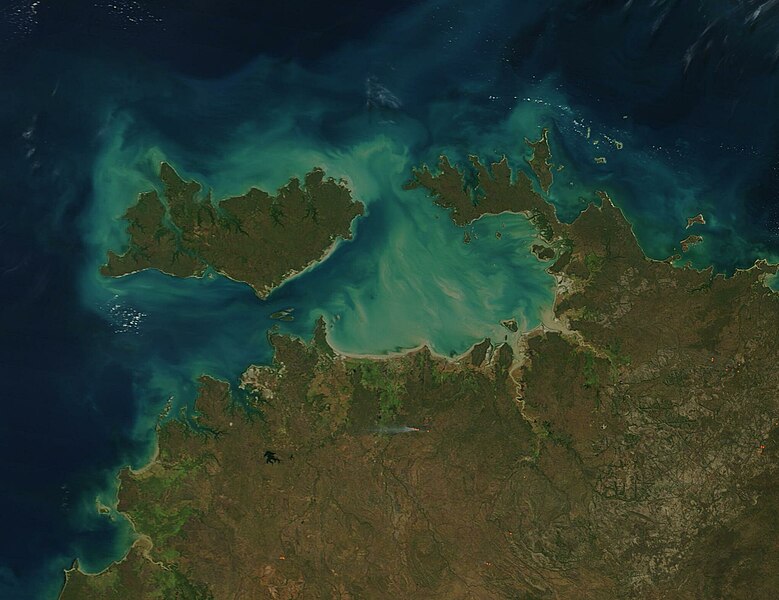File:Colorful Van Diemen Gulf, Northern Territory, Australia (MODIS).jpg

Original file (2,036 × 1,567 pixels, file size: 230 KB, MIME type: image/jpeg)
Captions
Captions
Summary[edit]
| DescriptionColorful Van Diemen Gulf, Northern Territory, Australia (MODIS).jpg |
English: Gorgeous jewel-toned colors created a spectacular glow in the Van Diemen Gulf in June 2023. The Moderate Resolution Imaging Spectroradiometer (MODIS) on board NASA’s Terra satellite acquired a true-color image of the colorful Van Diemen Gulf on June 13. Similar colors tint the water north of the Tiwi Islands, especially the two main islands of Bathurst (west) and Melville (east). These islands sit so close together that they often look like a single, larger, island from above.
Sometimes nicknamed “the bathtub”, in honor of it’s warm and shallow waters, the Van Diemen Gulf spans the waters of Australia’s Northern Territory between Melville Island, the Cobourg Peninsula, and the mainland coast. The large semi-enclosed embayment has a surface area of about 16,000 square kilometers (6,178 square miles) and is less than 20 meters (66 feet) deep. It also has a large tidal range measuring around 3 meters (9.8 feet) overall in the rainy season and even greater in the southeast end, near where the Alligator Rivers pour into the Gulf. The large change in height between low and high tides create strong tidal currents, which scour sediment off the Gulf’s floor and keep it suspended in the waters, especially during or shortly after the rainy season. This is the same time that sediment load in the numerous rivers that reach the Van Diemen Gulf is at their peak. The rainy season in western Top End typically begins in November and ends by mid-May. Given that waters are still high and rivers full in mid-June, the colors captured in Van Diemen Gulf in this image are almost certainly primarily from sediment. Sediment appears mud-colored near the surface but reflectivity changes as it sinks, so deeper sediment appears green and sometimes blue. Similar colors can be created by blooms of microscopic plant-like organisms called phytoplankton, but studies have shown that sediment concentrations can be high enough in the Gulf to suppress the growth of phytoplankton. The colors off of the Tiwi Islands are also likely primarily sediment, but conditions in the open water off the islands can also be favorable for phytoplankton growth. |
||
| Date | Taken on 13 June 2023 | ||
| Source |
Colorful Van Diemen Gulf, Northern Territory, Australia (direct link)
|
||
| Author | MODIS Land Rapid Response Team, NASA GSFC |
 |
This media is a product of the Terra mission Credit and attribution belongs to the mission team, if not already specified in the "author" row |
Licensing[edit]
| Public domainPublic domainfalsefalse |
| This file is in the public domain in the United States because it was solely created by NASA. NASA copyright policy states that "NASA material is not protected by copyright unless noted". (See Template:PD-USGov, NASA copyright policy page or JPL Image Use Policy.) |  | |
 |
Warnings:
|
File history
Click on a date/time to view the file as it appeared at that time.
| Date/Time | Thumbnail | Dimensions | User | Comment | |
|---|---|---|---|---|---|
| current | 18:54, 31 July 2023 |  | 2,036 × 1,567 (230 KB) | OptimusPrimeBot (talk | contribs) | #Spacemedia - Upload of http://modis.gsfc.nasa.gov/gallery/images/image06142023_250m.jpg via Commons:Spacemedia |
You cannot overwrite this file.
File usage on Commons
There are no pages that use this file.